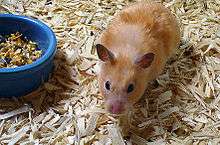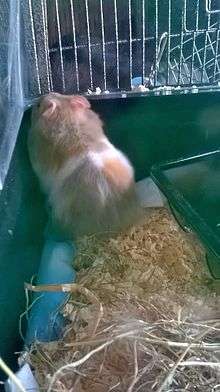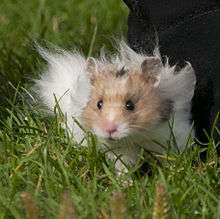Syrian hamster variations

The golden hamster or Syrian hamster kept as a pet or research animal typically has a golden colored coat, but occasional variations due to normal genetic diversity or mutation have been recognised and selected by breeders, so that there are now a wide variety of coat colors and types available.
Colours
Colours can be described in three ways: as "self", "agouti" or "combinations". Self colours will be a consistent coat colour with the same colour topcoat and undercoat. Agouti hamsters have a different, lighter undercoat and will have markings around the eyes. Combinations are produced when two (or more) self or agouti colours are present.
Beige
Beige is a rare colour, because it is produced by breeding together a hamster with the rust and dark grey gene, which are, themselves, rare.[1] The beige variety is often smaller than the rest of the litter and may have a kinked tail.
| Variation | Genotype |
|---|---|
| Beige | bbdgdg |
Black

The black colour was imported to the UK in 1991.[2] Before then, Sables were referred to as black, but are lighter than the actual black bear hamsters. Black bear hamsters have a consistent jet black coat, with some white on the paws and belly. The black gene is recessive, which is why the variation was not discovered until recently. The discovery of the black hamster has allowed scientists and breeders to produce many new variations, including Dove, when bred with cinnamon hamsters, and chocolate, when combined with rust.
| Variation | Genotype |
|---|---|
| Black | aa |
Cream
The cream variety ranges from sandy to orange-cream. This variation (a naturally occurring mutation)[3] was first discovered in the United Kingdom in 1951[4] and is a "self" colour. There are further sub-types of this variation, determined by the colour of their eyes, which can be black, red or ruby. Black eyed creams typically have dark grey ears, although this is not necessarily the case, whereas red eyed creams have flesh coloured ears.
| Variation | Genotype |
|---|---|
| Black eyed cream | ee |
| Red eyed cream | eepp |
| Ruby eyed cream | eeruru |
Sable
When it was discovered in 1975, this variation was originally named black. Since the discovery of the melanistic black variety, it has been renamed to sable. The topcoat is black and the undercoat is ivory cream, with a black belly, black eyes and dark-grey ears. The fur around the eyes is also ivory cream. Sable comes from Umbrous bred to Cream.
| Variation | Genotype |
|---|---|
| Sable | UUee |
White
There are three different types of white hamster: dark and flesh eared and black eyed. All three are completely white. The dark eared variety first appeared in 1952 and has red eyes which darken as the animal ages. Black eyed whites have flesh coloured ears. Flesh eared whites, often described as albinos, were first mentioned in the National Hamster Council Journal in 1956. As the name suggests, albinos have flesh ears and pink eyes.[5]
| Variation | Genotype |
|---|---|
| Black eyed white | eeDsds or eeWhwh |
| Dark eared white | cdcd |
| Flesh eared white (Albino) | cdcdpp |
Eyeless White Hamsters
Hamsters are often born with no eyes when breeding a White Bellied or Patterned Hamster to another White Bellied or Patterned Hamster,[6] called Anophtalmic or Eyeless Whites, but can survive well in spite of this. Hamsters don't rely on their eyesight as much as other mammals. They live below ground during the day and are active at twilight and near dawn so it doesn't affect them much. The hamster relies heavily on scent and the detection of vibrations, as well as sound to some extent. The constantly closed eyes and rarely empty eyesockets are unappealing to potential pet owners, but they make excellent pets all the same. They will recognize the voice and scent of their owner if they're handled regularly and gently, and are just as easily tamed as their sighted counterparts.
Albino Syrian Hamster
A true albino Syrian Hamster has yet to be discovered; the closest is a Red-Eyed White (sometimes called flesh-eared white). "Often classified as “albino” is the Flesh-Eared White. It's all white with bright pink eyes and flesh-coloured ears. The Flesh-Eared White is a combination of the Dark-Eared White and the Cinnamon gene. There is actually no true albino gene in Syrians, just the acromelanic gene." -Genevie, from Hamster Hideout Forum.[7]
Eyes and ears
The colour of a hamsters eyes and ears is usually determined by the coat colour. Some coat colours have several different eye and ear colour combinations, however, such as the cream variety which can have black, red or ruby eyes. Sometimes Hamsters can present Heterochromia, though this is a Genetic Fault cause by Poor Breeding.
Patterns
Banded (BaBa, Baba, or Ba-)
First reported in 1957,[8] a banded hamster will have a band of white around the middle. The width of the band will differ, from a small strip to most of the body. Most colours can exist banded.
Piebald
The first Piebald was reported in 1945.[9] A Piebald is a coloured hamster which has white spots on its body. The spots can be few and small or can cover the hamster. Piebalds can also have coloured bellies. This pattern is hard to breed and is believed to be extinct by some.[10]
Dominant Spot (Dsds)
The dominant spot variety was first discovered in America, in 1964[11] and quickly became more popular than the Piebald variety due to it being easy to breed. The variety is described by UK and US standards as "a white animal with coloured spots".
Roan (Whwh)
The roan pattern in Syrians consists of a white animal ticked with colour. The ticking shall be heavy around the head and give an evenly marbled appearance over the remainder of the top coat. The white areas shall be white to the roots. The coloured areas shall conform to the recognised coloured variety allowing for slight dilution. If roan is bred to another roan, dominant spot, banded, or white bellied hamster 25% of the litter will be Eyeless Whites.
Tortoiseshell (ToTo)

A tortoiseshell is a bi-coloured animal which consists of a balanced pattern of coloured and yellow patches. These patches shall be clear and distinct with no brindling. Only females can be Tortie as it is a Sex Linked gene.
Tortoiseshell and White (ToToBaba, ToToBaBa, or ToToDsds)
Like tortoiseshell but with a white band. Must have a white belly. Only females can be tortie and white as it is a sex linked gene.
Coat types
Shorthair (LL)
The first hamsters discovered were shorthairs. Shorthair hamsters simply have short hair.
Longhair (ll)

The longhair coat type is a hamster with hair which is up to 4 inches (10 cm).[12] They are often referred to as "teddy bears" by Pet stores due to their bear-like appearance and the ability to sell them easier.
Male Syrian's usually have much longer hair than female Syrian's. Hair is typically longer from the hips down, forming a 'skirt'.
Rex (rxrx)
A Rex Hamster's coat shall be soft and dense, and evenly "frizzy" and the whiskers shall be curly.
Breeding two Rex Hamsters together causes the eyelashes to curl into the Hamsters eyes which is very uncomfortable and shouldn't be done.
Satin (sasa)
Smooth shiny satin fur. Breeding two Satin's together creates thin, greasy fur and is not recommended.
References
- ↑ Beige
- ↑ Black
- ↑
- ↑ Hamsters: Black Eyed Cream Syrian Hamster
- ↑ Hamsterlopedia by Chris and Peter Logsdail, ISBN 1-86054-246-8, page 137
- ↑ "Anophthalmic, or eyeless whites". Retrieved 2015-11-25.
- ↑ "Difference between White Syrians and Albino Syrians - The Different Species". Hamster Hideout Forum. Retrieved 2015-11-25.
- ↑ Hamsterlopedia by Chris and Peter Logsdail, ISBN 1-86054-246-8, page 138
- ↑ Hamsterlopedia by Chris and Peter Logsdail, ISBN 1-86054-246-8, page 138
- ↑ Hamsters: Syrian Hamster Patterns
- ↑ Hamsters: Dominant Spot Syrian Hamster
- ↑ Hamsterlopedia by Chris and Peter Logsdail, ISBN 1-86054-246-8, page 139
To avoid confusion, all genomes listed are those stated in Hamsterlopedia by Chris and Peter Logsdail, ISBN 1-86054-246-8, unless referenced otherwise. Some sources may use different sources.